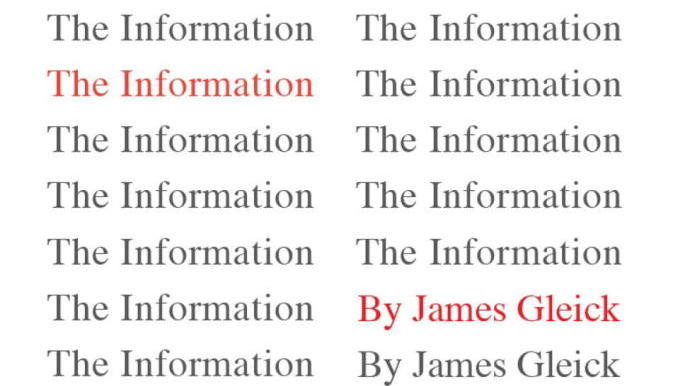The Information, by James Gleick: A Review
"And then, when it was made simple, distilled, counted in bits, information was found to be everywhere."

The books which surprise you the most often are books you have never read about, written by authors you have never heard of, upon which you stumble unsuspectingly. I can recall only one such case prior to the book I am reviewing today: “The Shadow of the Wind”, by Carlos Ruiz Zafón, currently my favorite fiction novel.
Indeed, I had never heard of James Gleick or his books when I found a peculiar black-and-white paperback on a dusty shelf during the annual “Braderie du Livre” at the USJ-CSM campus, a book clearance/sale kind-of event. Being a hunter and devourer of books tackling scientific subjects in a literary style, I immediately picked it up and added it to my ever-growing science book collection. This proved to be a good decision.
The book I am talking about is called: “The Information: A History, A Theory, A Flood”.
To call it ambitious would be a mere euphemism. The amount of information(!) contained in this 427-page tour de force would require many a reading and note-taking for it to be fully assimilated. Fifty more pages contain the references to every quote, fact and theorem cited throughout the book. I cannot imagine how long it must have taken the author to research all of this information, never mind the time it took to incorporate it all into such a well-written and accessible manner…!
In “The Information”, James Gleick dissects the history of information theory and creates a comprehensive biography of information itself. He brings to life a list of eminent scientists, whose fundamental work, stripped of their context by impatient teachers merely half a century later, has unfortunately turned into torture for budding engineering students around the globe! Claude Shannon, John von Neumann, James Clerk Maxwell, Albert Einstein, Erwin Schrödinger and many more, appear under a new light, with their work carefully explained and their contributions to information theory meticulously mapped out. Evidently, information theorists, those great thinkers and visionaries, take center stage: from Charles Babbage and Kurt Gödel to Alan Turing, passing by the brilliant Ada Byron, Countess of Lovelace, the world’s first computer programmer… An honorable mention goes to some illustrious fiction writers, who were also ahead of their time when they envisioned massive centralized libraries of information and machines which can think, such as Edgar Allan Poe, José Luis Borges and Lewis Carroll.
Nowadays, the word “information” and what it represents have become quite trivial, as we live in a world where information is practically free and at the tip of our fingers. But there was a time when the word ‘information’ was not in use, when information wasn’t quantized with bits, shared, amassed, processed or even known. For years on end, theorists struggled to put a tag on what was known as the accumulation of knowledge, and they despised the very idea of dissociating information from meaning, something computer engineers and scientists do every day now.
In less than thirty years, we have completely transitioned from telegraphs, Morse code and encyclopedias, to computers, coding languages and Wikipedia. In retrospect, it did not take much time. But the transition would not have been so successful and widespread were it not for those incredible thinkers, who came up with obscure theoretical proofs, insipid theorems, and wild thought experiments. I feel eternally grateful to them, because their work has allowed me to have food for thought, an illuminating book to read, a field of study to major in, and a public platform to share my own thoughts with the world.
I cannot stress enough how important this book is for anyone who is even mildly interested in how the Internet and how our present world came to be. It is a long read, but if you tackle it slowly, it will prove to be extremely rewarding.
I am eager to discover more of James Gleick’s books, but I will undoubtedly read “The Information” again, as I am sure there is much more yet to discover.
“For the purposes of science, information had to mean something special. Three centuries earlier, the new discipline of physics could not proceed until Isaac Newton appropriated words that were ancient and vague—force, mass, motion, and even time—and gave them new meanings. Newton made these terms into quantities, suitable for use in mathematical formulas. Until then, motion (for example) had been just as soft and inclusive a term as information. For Aristotelians, motion covered a far-flung family of phenomena: a peach ripening, a stone falling, a child growing, a body decaying. That was too rich. Most varieties of motion had to be tossed out before Newton’s laws could apply and the Scientific Revolution could succeed. In the nineteenth century, energy began to undergo a similar transformation: natural philosophers adapted a word meaning vigor or intensity. They mathematicized it, giving energy its fundamental place in the physicists’ view of nature.
It was the same with information. A rite of purification became necessary.
And then, when it was made simple, distilled, counted in bits, information was found to be everywhere.”
― James Gleick, The Information: A History, a Theory, a Flood
-J.




Share this post
Twitter
Facebook
Reddit
Email